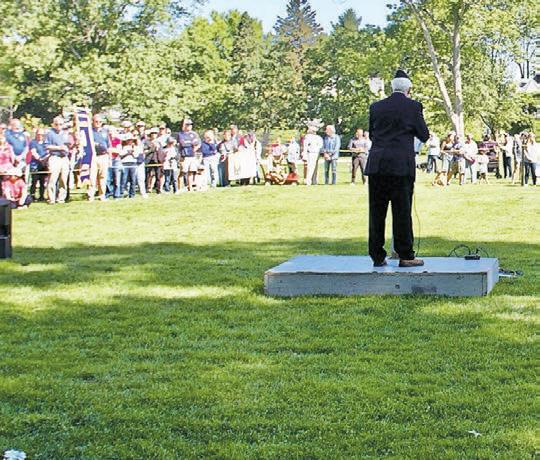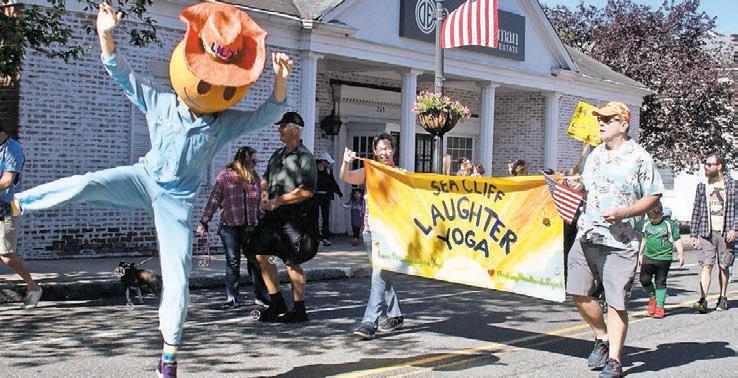


Elisa Dragotto/Herald
An invocation, written 13 years ago by former Reverend Kirtland Watkins of Sea Cliff United Methodist Church, was read in his tribute at Sea Cliff’s annual Memorial Day parade.




Elisa Dragotto/Herald
An invocation, written 13 years ago by former Reverend Kirtland Watkins of Sea Cliff United Methodist Church, was read in his tribute at Sea Cliff’s annual Memorial Day parade.
By LUKE FEENEY lfeeney@liherald.com
An invocation, written 13 years ago by former Reverend Kirtland Watkins of Sea Cliff United Methodist Church, was read in his tribute at Sea Cliff’s annual Memorial Day parade.
Watkins, who was a consistent presence at the village’s parade, died at 77 in August of last year.
Long-time Sea Cliff resident and former deputy mayor Philip Como shared the written work by Watkins at Clifton Park. Watkins first wrote and presented it on Memorial Day in 2012. Watkins’ invocation and prayer analyzed the sacrifices made by the men and women who served in the U.S.
Armed Forces.
“Remembering the soldiers of any warcalling out their names, singing their songs, or just thinking about the fact that they fought - brings out the real cost of war,” Como read from Watkins’ invocation. “The voices of the dead cry out to us for peace. It is a sacred thing to remember the soldiers, to allow their lives to place a claim upon us.”
The death toll of the American soldiers who fought in the Civil War, both world wars, Korean War, Vietnam War, Persian Gulf War, Iraq War, and the Afghan War were read in the next portion of the invocation. “Remember them,” Como read after the number of casualties from each war.
“Lord of the nations, on this day when we

By WILL SHEELINE & LUKE FEENEY of the Herald
A multi-year saga finally ended as Jupiter Power, a Texasbased battery storage company owned by BlackRock, has cancelled its contract to build the Oyster Shore Energy Storage following a grassroots effort by Glen Head, Glenwood Landing and Sea Cliff residents in opposition to the proposal.
The project, first proposed to the Town of Oyster Bay in 2022, had generated controversy among residents from the outset, sparked by fears over fire safety, impact on property value, traffic and environmental concerns.
Tcritic of the project, said. “The community as a whole is thrilled about this news.”
The announcement came after three separate extensions of six-month moratoriums on the development of lithium battery facilities, protests by citizens and elected officials and several public hearings.
here were a lot of concerns with the development like this in a densely populated area. I think with those safety questions unanswered; it’s the best outcome.
CHRIS ZUBLIONIS
North Shore District Superintendent
“We’re elated. I mean, we are as happy as we can be,” George Pombar, president of the Glen Head-Glenwood Civics Council, trustee of the Water Authority of North Shore and outspoken
The proposed 275-megawatt battery energy storage system would have replaced the current Global Petroleum terminal at the corner of Glen Head Road, Shore Road, and Glenwood Road near Tappen Beach in Glenwood Landing.
The Texas-based battery storage company stated in a press release that the decision was made following a recent evaluation of projects in active development across the United States. Additionally, the company will refocus its development efforts elsewhere, although it does not specify the
CONTINUED ON PAGE 2

By LUKE FEENEY lfeeney@liherald.com
Residents, elected officials, and community leaders paid their respect and honored the men and women who died in combat while serving in the U.S. Armed Forces at Sea Cliff’s annual Memorial Day parade.
The parade began at 9:00 a.m. at Memorial Park on Prospect Avenue. Following a brief ceremony, the parade proceeded down Sea Cliff Avenue, then to Roslyn Avenue, and then to Glen Avenue, concluding with a ceremony and speakers at Clifton Park.
Fitting with the day’s themes of honor and remembrance, those who died in combat were saluted at the beginning of the parade in Memorial Park and the end of the parade in Clifton Park.
Several local organizations in Sea Cliff were present in the parade, including the Friends of the Sea Cliff Village Library, the Village Museum, and many others. In addition, local marching bands from the North Shore School District also participated.
Congress passed the Uniform Monday Holiday Act in 1968, which established Memorial Day as the last Monday in May to create a three-day weekend for federal employees. The change went into effect in 1971. The same law also declared Memorial Day a federal holiday.



By WILL SHEELINE wsheeline@liherald.com
Pulitzer Prize-winning historian Ron Chernow delivered the keynote address at the Gold Coast Book Fair on May 16, captivating a full auditorium at LIU Post with a spirited exploration of Mark Twain’s life, legacy — and contradictions. The presentation came on the heels of the release of Chernow’s newest book, “Mark Twain,” a glimpse into the life of America’s greatest humorist.
Former U.S. Rep. Steve Israel, the owner of Theodore’s Books, in Oyster Bay, and the founder of the book fair, introduced Chernow and explained why he created the event, emphasizing the importance of not only supporting books and reading, but also putting Long Island on the map as a literary hotspot.
“Long Island is frequently overlooked as the literary treasure that it is,” Israel said. “(Chernow) joins us for the kickoff event of an extraordinary weekend celebrating our history, our democracy and our love of literature.”
Chernow opened with a personal anecdote from 1974, when he saw the actor Hal Holbrook perform his legendary one-man show as Mark Twain.
“Holbrook stood up there for 90 minutes in the trademark Mark Twain white suit with the cigar, with the unruly mustache, and he spouted one

political witticism after another. And I was just laughing hysterically,” Chernow recalled. “I still remember many of them, of Mark Twain saying there’s no distinctly Native American criminal class except for Congress. Sorry, Congressman Israel.”
Chernow noted the ongoing relevance of Twain’s caustic humor, which he often aimed at political corruption. He added that Twain’s digs at the Gilded Age crooks of his times “are still very relevant today.”
The biographer, best known for his works on Alexander Hamilton and Ulysses S. Grant, said he was drawn to Twain because of the profound duality in his life. He pointed to a Ken Burns documentary that opened his eyes to the “life of tremendous personal tragedy and complexity.”
Twain found the humor in the serious, the tragic and even the sacred aspects of life. Chernow said that Twain liked to intentionally shock people with his escapades. “He even promised at one event that he would, quote, ‘devour a child in the presence of the audience, if some lady will kindly volunteer an infant for the occasion.’”
Chernow delved into Twain’s early years, describing his father as a cold, distant man who left young Sam Clemens with a lifelong fear of poverty. In contrast, Twain’s emotional foundation came from his mother, Jane Lampton

Editor’s note: Please join Michael Ettinger’s live Zoom webinar “Four Advantages of Using Trusts” on Wednesday, June 4 at 7 pm or Wednesday, July 9 at 7 pm. Kindly register on our website, trustlaw.com
Clients often ask whether the home should be deeded to the client’s adult children, while retaining a life estate in the parent or whether the Medicaid Asset Protection Trust should be used to protect the asset. While the deed with a life estate will be less costly to the client, in most cases it offers significant disadvantages when compared to the trust. First, if the home is sold prior to the death of the Medicaid recipient, the life estate value of the home will be required to be paid towards their care. If the house is rented, the net rents are payable to the nursing facility since they belong to the life tenant. Finally, the client loses a significant portion of their capital gains tax exclusion for the sale of their primary residence as they will only be entitled to a pro rata share based on the value of the life estate to the home as a whole. Nevertheless, a life estate deed makes sense for a vacation home that is intended to stay in the family.
All of the foregoing may lead to a situation where the family finds they must maintain a vacant home for many years. Conversely, a properly drafted MAPT preserves the full capital gains tax exclusion on the sale of the primary residence and the home may be sold by the trust without obligation to make payment of any of the principal towards the client’s care, assuming we have passed the look-back period for facility care of five years.
It should be noted here that both the life estate and the MAPT will preserve the stepped-up basis in the property provided it is sold after the death of the parent who was the owner or grantor. Upon the death of the parent, the basis for calculating the capital gains tax is stepped up from what the parent paid, plus any improvements, to what it was worth on the parent’s date of death. This effectively eliminates payment of capital gains taxes on the sale of appreciated property, such as the home, after the parent dies.

Will Sheeline/Herald
Ron Chernow discussed Mark Twain’s literary legacy and his remarkable life, and shared many of his wittiest remarks.
Clemens, a lively, humorous woman who bore an uncanny resemblance to her son in wit and manner.
“Twain had been a premature baby,” Chernow said, recalling a favorite exchange. “Years later, Twain asked his mother whether she had been uneasy about his health. ‘Yes, the whole time,’ she agreed. And Twain persisted, ‘Afraid I wouldn’t live?’ And then, with a deadpan worthy of her son, she replied, ‘No, afraid you would.’”
The future author’s early jobs included working as a printer’s apprentice for his brother, Orion’s, newspaper, where, Chernow said, Twain began writing “satiric scripts,” his first literary ventures.
Chernow also described Twain’s fantastical plan to become a coca magnate after reading an account of Inca laborers chewing coca leaves. Twain boarded a boat to New Orleans with dreams of wealth, only to find there was no passage to Brazil. Instead he met a steamboat pilot named Horace Bixby who offered to train him. Twain later earned a pilot’s license and a salary “equivalent to that of the Vice President of the United States.”
The Civil War ended Twain’s steam-
■ WEB SITES: seacliff.liherald.com glenhead.liherald.com
boat career, and after a brief and undistinguished stint in a Confederate militia — “I knew more about retreating than the man who invented retreating,” Twain quipped — he headed west with Orion. In Nevada Twain became city editor of the Territorial Enterprise, where his pen name was born. “For his pen name, he adopted a term from his steamboat days, Mark Twain,” Chernow explained. “What Mark Twain meant was two fathoms, or 12 feet of water.”
Chernow described Twain’s colorful battles at the paper with rival journalists, hoaxes, and the wild frontier humor that shaped his voice.
Though he is most remembered for “The Adventures of Tom Sawyer” and “Huckleberry Finn,” Twain’s best-selling work during his lifetime was “The Innocents Abroad,” a travelogue satirizing Europe and the Holy Land.
“Suddenly, a new voice in American letters emerged,” Chernow said. “It was brash and cynical, irreverent, exuberant and totally hilarious.”
Twain had no patience for the Old World’s art and saints. He called Michelangelo’s Sistine Chapel “a nightmare” and described da Vinci’s “Last Supper” as inferior to the copies being painted in front of it.
The author’s life changed on that same European tour when he glimpsed a miniature portrait of a young woman named Olivia Langdon, who became his wife.
Closing on a poignant note, Chernow remarked on the challenges of writing a biography of a man who once said, “The biography of the man himself cannot be written.” But Twain’s contradictions — his joy and sorrow, comedy and critique — continue to challenge and enchant.
Israel and Chernow spent the next 30 minutes in a Q&A-style-discussion, covering topics ranging from Twain’s opinion of Theodore Roosevelt (Twain thought Roosevelt was “a clown with the whole world for an audience”) to Chernow’s use of index cards when researching (he used more than 25,000 when writing “Mark Twain”).
“’I’m not an American, but the American,’ Twain once wrote,” Chernow added with a smile. “Arrogant, but perhaps true.”
■ E-MAIl: Letters and other submissions: seacliffeditor@liherald.com, glenheadeditor@liherald.com
■ EDITORIAl DEPARTMENT: Ext. 327 E-mails: seacliffeditor@liherald.com, glenheadeditor@liherald.com
■ SUBSCRIPTIONS: Press ”7” E-mail: circ@liherald.com Fax: (516) 569-4942
■ ClASSIFIED ADVERTISING: Ext. 286 E-mail: ereynolds@liherald.com Fax: (516) 622-7460
■ DISPlAY ADVERTISING: Ext. 249 E-mail: rglickman@liherald.com Fax: (516) 569-4643
■ PUBlIC NOTICES: Ext. 232 E-mail: legalnotices@liherald.com







‘Blood Alley’ stretch lives up to its name on roadway with grim total of over 3,000 crashes per year
By BRIAN NORMAN bnorman@liherald.com
Third in a series on the Southern State Parkway.
The 23.5 miles of the Southern State Parkway, which stretches from the Queens-Nassau border to Heckscher State Park in East Islip, has daily traffic congestion and frequent accidents, so numerous that one portion is called “Blood Alley.”
There have been over 3,000 accidents a year on the parkway since 2021, a majority of which occurred in Nassau County, according to New York State Police. Last year, 15 of those crashes were fatal, the highest number in recent years.
The section of parkway between exits 17 and 32 is widely referred to as Blood Alley due to its high accident rates, which include several fatalities. The road’s narrow lanes, sharp turns and poor lighting have all contributed to its dubious distinction as one of the most dangerous roadways in the country.
Elmont resident Winston Waters said that he has lived in the area for 40 years, and has often found himself having to plan his day around the congestion of the parkway.
“I work around it as much as I can,” Waters said. “There are times when I have to leave early to get to work — you know, I’ve got to deal with that — but I try to work around it. I try and leave very early, after rush hour, before rush hour, those kinds of things.”
Waters said his backyard once resembled a national park, with thick trees that helped muffle the sound of the nearby parkway. But since the trees were removed because of their age, the noise has become a growing issue, and the constant congestion is beginning to spill into the community, disrupting daily life.

see the roadway.
And despite the noise, she is not a fan of the huge sound walls erected on other roadways, such as the Long Island Expressway. “The walls are kind of ugly, Kordulak said.

“I personally didn’t want to see that much traffic in the area,” he added, “because it (creates) a lot of congestion, particularly if there’s an accident or there’s in the morning, rush hour — you have a lot of people that come through, come off the exit and then they want to maneuver through the side streets, which decreases the quality of life.”
Blood Alley lived up to its name in January, when a car overturned near Exit 29 in North Massapequa, killing two people and seriously injuring two others. The driver was speeding and weaving in and out of traffic before losing control and crashing into a tree, police reported.
South Park Drive, in North Massapequa, sits within sight of the parkway and Sharyn Kordulak can see vehicles whizzing by from the front of her house.
“You get used to all the noise, the drone of the traffic,” Kordulak said, noting that some neighbors have blocked out portions of the cyclone fence on the opposite side of the street so they don’t
Valley Stream resident Patrick Goin, who has been an advocate for safer conditions along the highway, specifically near Exit 13 in Valley Stream, said that he is hopeful that the myriad complaints about the parkway complaints will be addressed.
“I’m the one who spoke with Carrié for something to be done about that intersection, because my uncle had a severe car accident where he almost died and his car was totaled,” Goin said, referring to Nassau County Legislator Carrié Solages. “There’s been a few accidents. My uncle wasn’t the first, so that’s being addressed.”
Goin added that he lives right near Exit 13, and that speeding by motorists coming on and off of the parkway has become a recent issue for him and his neighbors when they try to leave their homes.
Exit 13, which serves both Central Avenue south and Linden Boulevard north in Valley Stream, is one of the more widely reviled entry and exit points along the highway, with residents calling for fixes for several years.
In 2018, Valley Stream resident Nayyer Zubair created a petition that documented residents’ concerns about safety. The petition, which currently has 672 signatures, calls for the addition of leftturn lanes and signals on Central Avenue to facilitate safer turns onto Stuart Avenue; lighting upgrades to enhance

pedestrian visibility and safety; and the addition of traffic cameras to deter redlight violations and other dangerous driving behaviors.
The state Department of Transportation unveiled a plan on May 8 to reconstruct eastbound Exit 13, with construction set to begin in the spring of 2027. The project aims to create safer conditions for drivers entering and exiting the parkway.
However, some residents questioned the need to reconstruct the entire exit.
Valley Stream resident Dayle Cohen said she recognized the issues that occur at the exit, but questioned how a massive project like this could affect the community even more.
“I drive this route often,” Cohen said. “I know a lot of people run the stop sign when you’re getting up (the ramp to) the highway. People coming from the Linden (Boulevard) side always struggle to make their right lane on Stuart. But I really haven’t noticed any (bigger)
issues. I’m not an expert — I don’t know the traffic patterns. I don’t know the statistics, and my only concern was people run the stop sign, but then you wait a minute and it’s no big deal. I’m not sure about the price tag and how it will affect people who actually live right here, but I personally didn’t see a need for it.”
In Islip Terrace, not far from the Southern State’s eastern terminus, Jo Borda has lived off Spur Drive South, on Juniper Street, for 33 years, and though the parkway is wider there than in its western portion, accidents still occur.
“All times of the day, people are turning too fast off the exit and crashing on the turn,” Borda said. “Once right into the corner house.”
The former Franklin Square resident had advice for motorists. “People just need to slow down,” Borda said.
Additional reporting by Jeffrey Bessen. Next installment: Engineering challenges, infrastructure needs.